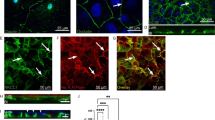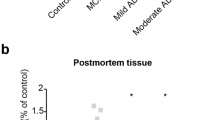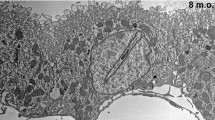Abstract
Objectives
Choroid plexus (CP) epithelial cells have multiple functions in the cerebral ventricles, including cerebrospinal fluid (CSF) production and forming part of the blood–CSF barrier. They are also responsible for producing inflammatory mediators involved in meningitis. The present study aimed to elucidate the functions of the CP epithelial cells during CNS inflammation.
Materials and methods
We analyzed the proteome and phosphoproteome in lipid A-treated ECPC-4 mouse CP cells by gel electrophoresis and mass spectrometry.
Results
Levels of 10 proteins and seven phosphoproteins were significantly altered by lipid A in time-dependent manners, including V-type proton ATPase subunit B (ATP6V), protein 40 kD, elongation factor-1δ, coatomer subunit ε (COPE), vimentin (isoform CRA a), purine nucleoside phosphorylase, eukaryotic initiation factor-4F splicing variant, put. β-actin, peroxiredoxin-6 isoform 1, and immunoglobulin heavy chain variable region. These proteins could be classified as having cytoskeleton/intermediate filament, protein-folding, signal-transduction, cell-growth, metabolism, and redox-regulation functions. The identified phosphoproteins were HSP 84, γ-actin, HSP 70 cognate, vimentin, tubulin β-4B chain, protein disulfide-isomerase A6 precursor, and heterogenous nuclear ribonucleoprotein, which could be classified as having cytoskeleton/intermediate filament, protein-folding, and metabolism functions.
Conclusions
These results indicate that lipid A can change the levels of proteins and phosphoproteins in ECPC-4 cells, suggesting that the identified proteins and phosphoproteins may play important roles in inflammation of the CP.



Similar content being viewed by others
References
Johanson CE, Duncan JA, Klinge PM, Brinker T, Stopa EG, Silverberg GD. Multiplicity of cerebrospinal fluid functions: new challenges in health and disease. Cerebrospinal Fluid Res. 2008;5:10.
Chodobski A, Szmydynger-Chodobska J. Choroid plexus: target for polypeptides and site of their synthesis. Microsc Res Tech. 2001;52:65–82.
Engelhardt B, Sorokin L. The blood–brain and the blood–cerebrospinal fluid barriers: function and dysfunction. Semin Immunopathol. 2009;31:497–511.
Strazielle N, Ghersi-Egea JF. Choroid plexus in the central nervous system: biology and physiopathology. J Neuropathol Exp Neurol. 2000;59:561–74.
Schwerk C, Tenenbaum T, Kim KS, Schroten H. The choroid plexus—a multi-role player during infectious diseases of the CNS. Front Cell Neurosci. 2015;9:80.
Steffen BJ, Breier G, Butcher EC, Schulz M, Engelhardt B. ICAM-1, VCAM-1, and MAdCAM-1 are expressed on choroid plexus epithelium but not endothelium and mediate binding of lymphocytes in vitro. Am J Pathol. 1996;148:1819–38.
Engelhardt B, Wolburg-Buchholz K, Wolburg H. Involvement of the choroid plexus in central nervous system inflammation. Microsc Res Tech. 2001;52:112–29.
de Vries HE, Kuiper J, de Boer AG, Van Berkel TJ, Breimer DD. The blood–brain barrier in neuroinflammatory diseases. Pharmacol Rev. 1997;49:143–55.
Schwerk C, Adam R, Borkowski J, Schneider H, Klenk M, Zink S, et al. In vitro transcriptome analysis of porcine choroid plexus epithelial cells in response to Streptococcus suis: release of pro-inflammatory cytokines and chemokines. Microbes Infect. 2011;13:953–62.
Takano M, Satoh C, Kunimatsu N, Otani M, Hamada-Kanazawa M, Miyake M, et al. Lipopolysaccharide activates the kallikrein-kinin system in mouse choroid plexus cell line ECPC4. Neurosci Lett. 2008;434:310–4.
Takano M, Uramoto M, Otani M, Matsuura K, Sano K, Matsuyama S. Secretomic analysis of mouse choroid plexus cell line ECPC-4 using two-dimensional gel electrophoresis coupled to mass spectrometry. J Proteomics Bioinform. 2014;7:347–52.
Cohen P. The TLR and IL-1 signalling network at a glance. J Cell Sci. 2014;127:2383–90.
Li X, Jiang S, Tapping RI. Toll-like receptor signaling in cell proliferation and survival. Cytokine. 2010;49:1–9.
Otani M, Taniguchi T, Sakai A, Seta J, Kadoyama K, Nakamura-Hirota T, et al. Phosphoproteome profiling using a fluorescent phosphosensor dye in two-dimensional polyacrylamide gel electrophoresis. Appl Biochem Biotechnol. 2011;164:804–18.
Takano M, Maekura K, Otani M, Sano K, Nakamura-Hirota T, Tokuyama S, et al. Proteomic analysis of the brain tissues from a transgenic mouse model of amyloid beta oligomers. Neurochem Int. 2012;61:347–55.
Clague MJ, Urbe S. Ubiquitin: same molecule, different degradation pathways. Cell. 2010;143:682–5.
Nicola PA, Taylor CJ, Wang S, Barrand MA, Hladky SB. Transport activities involved in intracellular pH recovery following acid and alkali challenges in rat brain microvascular endothelial cells. Pflugers Arch. 2008;456:801–12.
Nanda A, Gukovskaya A, Tseng J, Grinstein S. Activation of vacuolar-type proton pumps by protein kinase C. Role in neutrophil pH regulation. J Biol Chem. 1992;267:22740–6.
Kimata Y, Higashio H, Kohno K. Impaired proteasome function rescues thermosensitivity of yeast cells lacking the coatomer subunit epsilon-COP. J Biol Chem. 2000;275:10655–60.
Mulner-Lorillon O, Minella O, Cormier P, Capony JP, Cavadore JC, Morales J, et al. Elongation factor EF-1 delta, a new target for maturation-promoting factor in Xenopus oocytes. J Biol Chem. 1994;269:20201–7.
Richter-Cook NJ, Dever TE, Hensold JO, Merrick WC. Purification and characterization of a new eukaryotic protein translation factor. Eukaryotic initiation factor 4H. J Biol Chem. 1998;273:7579–87.
Thouvenot E, Urbach S, Dantec C, Poncet J, Seveno M, Demettre E, et al. Enhanced detection of CNS cell secretome in plasma protein-depleted cerebrospinal fluid. J Proteome Res. 2008;7:4409–21.
Ray S, Fanti JA, Macedo DP, Larsen M. LIM kinase regulation of cytoskeletal dynamics is required for salivary gland branching morphogenesis. Mol Biol Cell. 2014;25:2393–407.
Moore SA, Oglesbee MJ. Involvement of the choroid plexus in the inflammatory response after acute spinal cord injury in dogs: an immunohistochemical study. Vet Immunol Immunopathol. 2012;148:348–52.
Giffard RG, Xu L, Zhao H, Carrico W, Ouyang Y, Qiao Y, et al. Chaperones, protein aggregation, and brain protection from hypoxic/ischemic injury. J Exp Biol. 2004;207:3213–20.
Lu TS, Chen HW, Huang MH, Wang SJ, Yang RC. Heat shock treatment protects osmotic stress-induced dysfunction of the blood-brain barrier through preservation of tight junction proteins. Cell Stress Chaperones. 2004;9:369–77.
Zugel U, Kaufmann SH. Immune response against heat shock proteins in infectious diseases. Immunobiology. 1999;201:22–35.
Acknowledgments
This work was supported by grants from the Smoking Research Foundation, Kobe Gakuin University for Collaborative Research A, and Grants-in-Aid for Scientific Research from the Ministry of Education, Culture, Sports, Science and Technology of Japan (Nos. 18023033, 21500352, 21390271, 20023027).
Author information
Authors and Affiliations
Corresponding author
Additional information
Responsible Editor: John Di Battista.
Rights and permissions
About this article
Cite this article
Takano, M., Otani, M., Kaji, T. et al. Proteomic analysis of mouse choroid plexus cell line ECPC-4 treated with lipid A. Inflamm. Res. 65, 295–302 (2016). https://doi.org/10.1007/s00011-016-0916-3
Received:
Revised:
Accepted:
Published:
Issue Date:
DOI: https://doi.org/10.1007/s00011-016-0916-3




